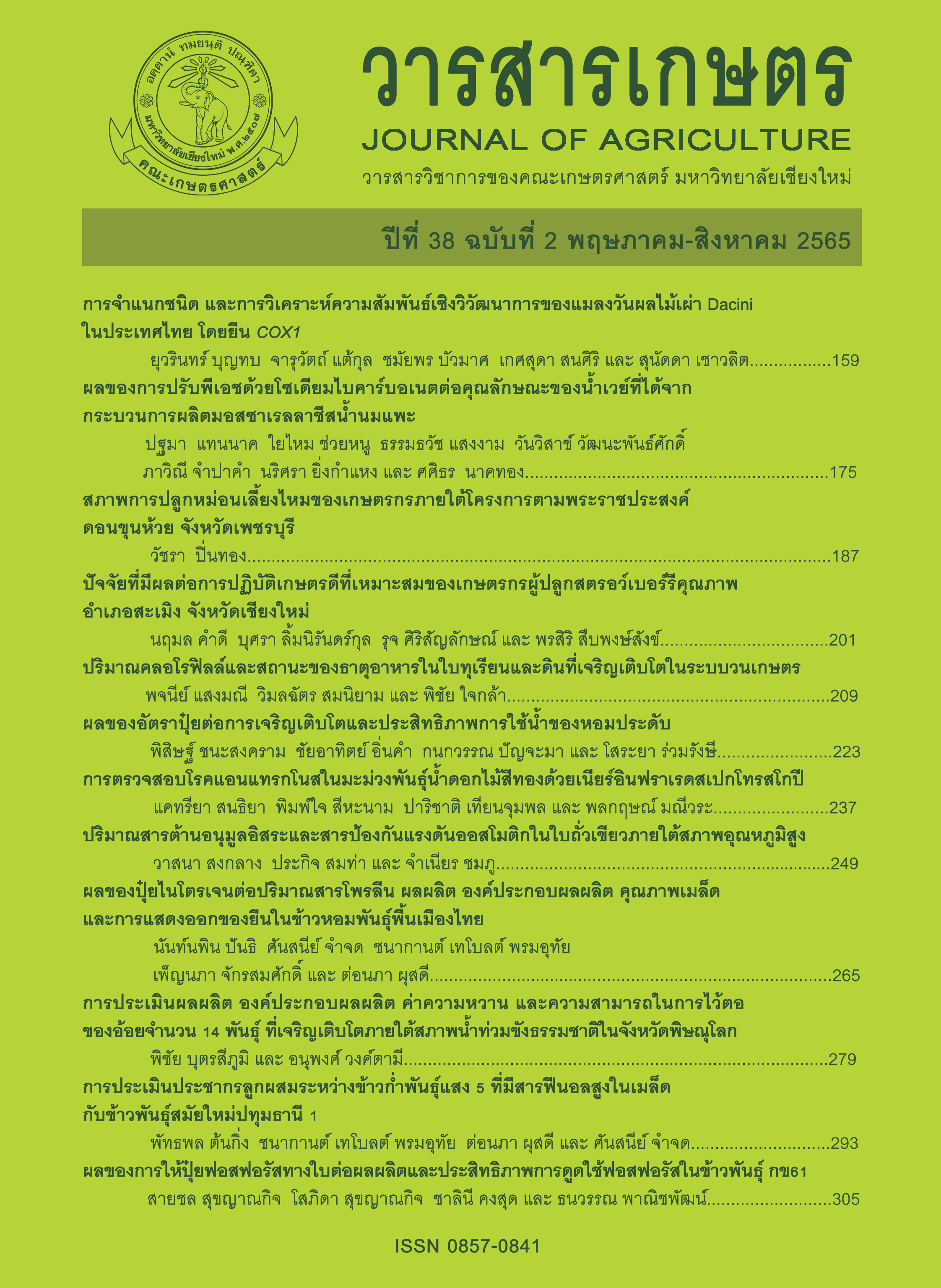Evaluation of Progeny Populations Between Purple Rice with High Grain Phenol cv. Saeng 5 and Modern Variety cv. Pathum Thani 1
Main Article Content
Abstract
Khao Saeng 5 (KS5) is a “Khao Kam” with purple kernel and contained high phenol content in rice grain. It is traditional improved variety by pure line selection method from purple rice landraces in the highlands of northern Thailand. Phenolic compounds are considered as essential substances found in purple rice with antioxidant properties help to reduce the risk of various major chronic diseases. However, KS5 is a landrace rice variety with lower yielding than the modern varieties. Therefore, to improve KS5 with higher yields, the hybridization was conducted between KS5 and the modern white rice variety Pathum Thani 1. This study aimed to evaluate the agronomical characteristics of first- and second-generation hybrids and select plants with high phenol content from the second - generation population. The results showed that almost agronomical characteristics of F1 plants grown in wet season 2017 was ranged between KS5 and PTT1, excepted plant height had exceeded their parents, while the percent of filled grain was lower than their parents. In dry season 2018, the 129 F2 plants with purple pericarp were selected from 280 F2 plants. Almost all the selected purple pericarp F2 plants had the range of almost agronomical characters wider than their parents, except the percentage of filled grain was lower than female parent KS5. Grain yield was varied between 6.2 - 56.5 g / plant and skewed to KS5. Phenol content showed a continuous distribution ranging from 28 to 272 mg gallic acid equivalent/100 g. There was no relationship between grain yield and phenol content. The eight F2 plants with the highest grain phenol ranging from 199.7 - 272.3 mg gallic acid equivalent / 100 g and grain yield ranging from 7.6 - 34.2 g / plant were selected. These F2 plant could be used as the genetic sources for subsequence selection to improve high grain quality purple rice.
Article Details

This work is licensed under a Creative Commons Attribution-NonCommercial-NoDerivatives 4.0 International License.
References
Chang, T.T and E.A. Bardenas. 1965. The Morphology and Varietal Characteristics of the Rice Plant. Technical Bulletin 4. The International Rice Research Institute, Laguna.
Folin, O. and V. Ciocalteu. 1927. On tyrosine and tryptophane determinations in proteins. The Journal of Biological Chemistry 73(2): 627-650.
Goffman, F.D. and C.J. Bergman. 2004. Rice kernel phenolic content and its relationship with antiradical efficiency. Journal of the Science of Food and Agriculture 84(10): 1235-1240.
Jaksomsak, P. 2007. Genetic control of iron content in rice grain. M.S. Thesis. Chiang Mai University, Chiang Mai. 93 p. (in Thai)
Jamjod, S., C. Thebault Prom-u-thai, N. Yimyam and S. Lordkaew. 2015. Collection, evaluation and characterization for special quality in Thai rice varieties from Chiang Mai, Chiang Rai and Mae Hong Son provinces. Final report. Lanna Rice Research Center, Chiang Mai University, Chiang Mai. 71 p. (in Thai)
Kaladee, D., P. Pongpiachan and S. Jamjod. 2000. Genetics, breeding and agriculture nutritional immunity of purple rice (Oryza sativa L.). Final report Science and Technology Research Institute. Chiang Mai University. Chiang Mai. 74 p. (in Thai)
Khempet, S. and S. Jongkaewwattana. 2012. Comparison of Agronomic Characteristics and Total Phenolic Content of Native Purple Glutinous Rice. Chiang Mai University Journal of Natural Sciences (Special Issue on Agricultural & Natural Resources) 11(1): 359-369.
Khodruankeaw, T., C. Thebault Prom-u-thai, T. Pusadee and S. Jamjod. 2020. Evaluation of progeny population between upland rice KumHomMorChor and photoperiod insensitive rice varieties. Khon Kaen Agriculture Journal 48(3): 535-546. (in Thai)
Min, B., L. Gu, A.M. Mc Clung, C.J. Bergman and M.H. Chen. 2012. Free and bound total phenolic concentrations, antioxidant capacities, and profiles of proanthocyanidins and anthocyanins in whole grain rice (Oryza sativa L.) of different bran colours. Food Chemistry 133(3): 715-722.
Pham, V.H. 2016. Phenolic compounds of cereals and their antioxidant capacity. Critical Reviews in Food Science and Nutrition 56(1): 25-35.
Plant Varieties Protection Office. 2020. Advertisement of a request for the certificate of a new plant variety registration according to the Plant Varieties Protection Act, B.E. 1975. (Online). Available: https://www.doa.go.th/pvp/wp-content/uploads/2020/11/AnnoDOA_Public233.pdf (August 5, 2021). (in Thai)
Rungwattanapong, T. 2011. Relationship between anthocyanin total phenolic content and antioxidant activities of local purple glutinous rice. M.S. Thesis. Chiang Mai University, Chiang Mai. 83 p. (in Thai)
Somboon, P., C. Thebault Prom-u-thai, T. Pusadee and S. Jamjod. 2017. Gene segregation for anthocyanin contents in F2 population between purple glutinous rice from highland and Pathum Thani 1 grown at lowland and highland locations. Journal of Agriculture 33(3): 323-332. (in Thai)
Xiao, J, C. Wu, Y. He, M. Guo, Z. Peng, Y. Liu, L. Liu, L. Dong, Z. Guo, R. Zhang and M. Zhang. 2020. Rice bran phenolic extract confers protective effects against alcoholic liver disease in mice by alleviating mitochondrial dysfunction via the PGC-1α-TFAM pathway mediated by microRNA-494-3p. Journal of Agricultural and Food Chemistry 68(44):12284-12294.


